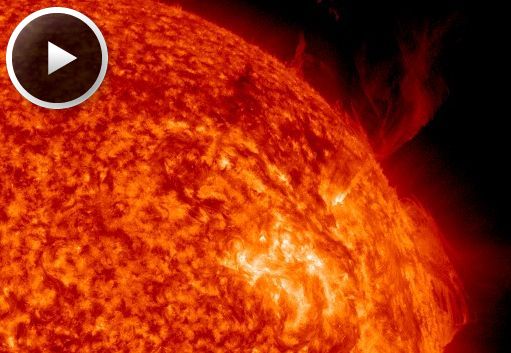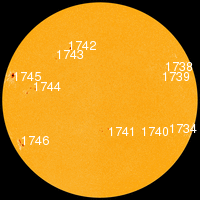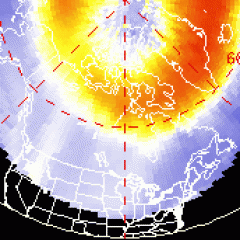~ Space Weather Update~ Early Morning~ FILAMENT ERUPTION: [1]
TRIPLE CONJUNCTION OF PLANETS: Venus, Jupiter, and Mercury are converging for a beautiful sunset conjunction. The show begins on May 11th and climaxes two weeks later. Get the full story [2] and a video [3] from Science@NASA [4].
FILAMENT ERUPTION: An unstable filament of magnetism on the Earthside of the sun erupted during the early hours of May 12th. NASA's Solar Dynamics Observatory recorded the blast:
The erupting filament did not spark a significant solar flare (that is, there was no strong flash of X-radiation), but it did hurl part of itself into space. SOHO photographed a bright coronal mass ejection (CME) emerging from the blast site: movie [6]. The CME could deliver a slight, glancing blow to Earth's magnetic field on May 15th. Aurora alerts: text [7], voice [8].
Realtime Space Weather Photo Gallery [9]
FANTASTIC SUNRISE: The sunrise over Australia on Friday, May 10th, was a little ... unusual. Tony O'Brien photographed what happened from a spot south of the town of Newman:
The sun had turned into a "ring of fire" during an annular solar eclipse. At the moment of O'Brien's snapshot, more than 95% of the sun's diameter was covered by the Moon.
"I travelled a full day to see this annular eclipse--and it was worth the trip," he says. "It was a fantastic event."
In an annular eclipse the Moon is not quite big enough to cover the entire solar disk. A blinding ring of solar fire juts out around the Moon, overwhelming the sun's delicate corona [11]. It may not be the same as totality, but annularity has a charm and beauty all its own. Browse the gallery [12] for more images from the eclipse zone.

![]()
Solar wind
speed: 347.2 km/sec
density: 1.6 protons/cm3
explanation [13] | more data [14]
Updated: Today at 1826 UT
![]()
X-ray Solar Flares
6-hr max: C2 1601 UT May12
24-hr: C2 0437 UT May12
explanation [15] | more data [16]
Updated: Today at: 1800 UT
![]()
![]()
![]()
Daily Sun: 12 May 13
![]()
![]()
Emerging sunspots AR1745 and AR1746 pose a threat for M-class [18] solar flares. Credit: SDO/HMI
![]()
![]()
![]()
Sunspot number: 145
What is the sunspot number? [19]
Updated 12 May 2013
Spotless Days
Current Stretch: 0 days
2013 total: 0 days (0%)
2012 total: 0 days (0%)
2011 total: 2 days (<1%)
2010 total: 51 days (14%)
2009 total: 260 days (71%)
Since 2004: 821 days
Typical Solar Min: 486 days
Update 12 May 2013
The Radio Sun
10.7 cm flux: 137 sfu
explanation [20] | more data [21]
Updated 12 May 2013
![]()
![]()
![]()
Current Auroral Oval:
![]()
Switch to: Europe, USA, New Zealand, Antarctica
Credit: NOAA/POES
![]()
![]()
![]()
Planetary K-index
Now: Kp= 2 quiet
24-hr max: Kp= 2 quiet
explanation [23] | more data [24]
![]()
Interplanetary Mag. Field
Btotal: 4.2 nT
Bz: 1.0 nT north
explanation [25] | more data [26]
Updated: Today at 1827 UT
![]()
![]()
![]()
Coronal Holes: 12 May 13
![]()
![]()
There are no large coronal holes on the Earthside of the sun. Credit: SDO/AIA.




